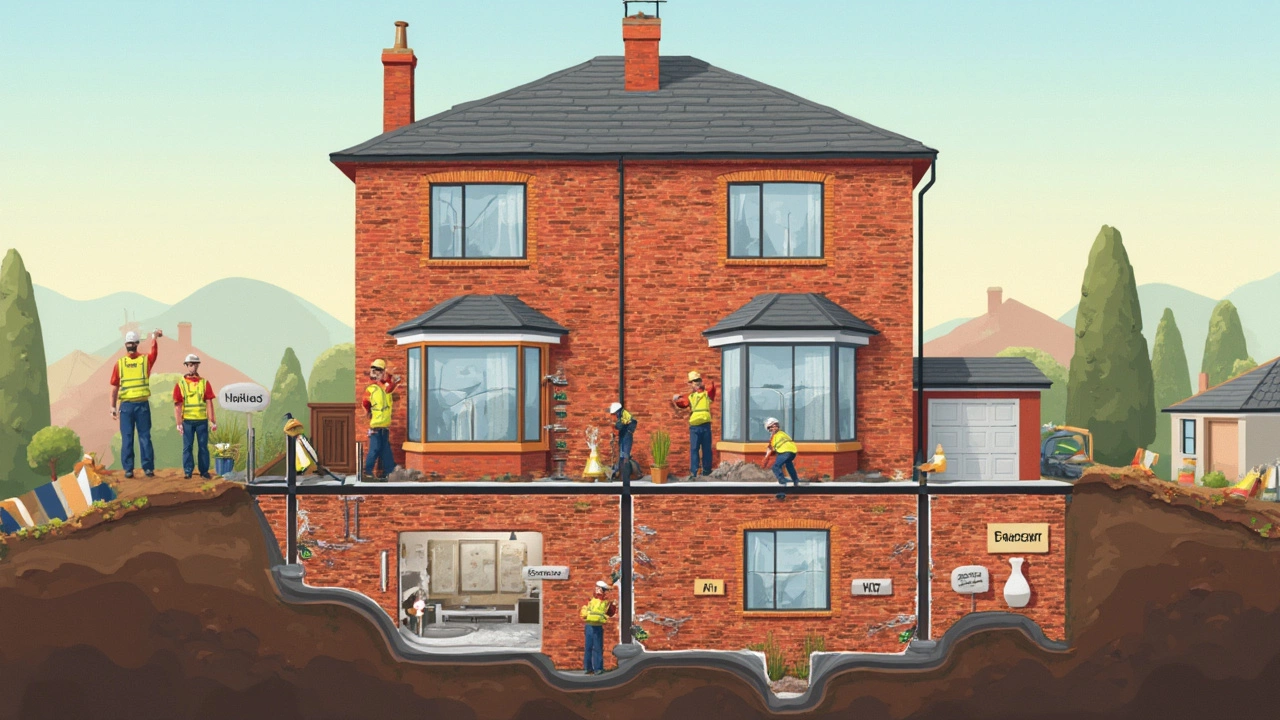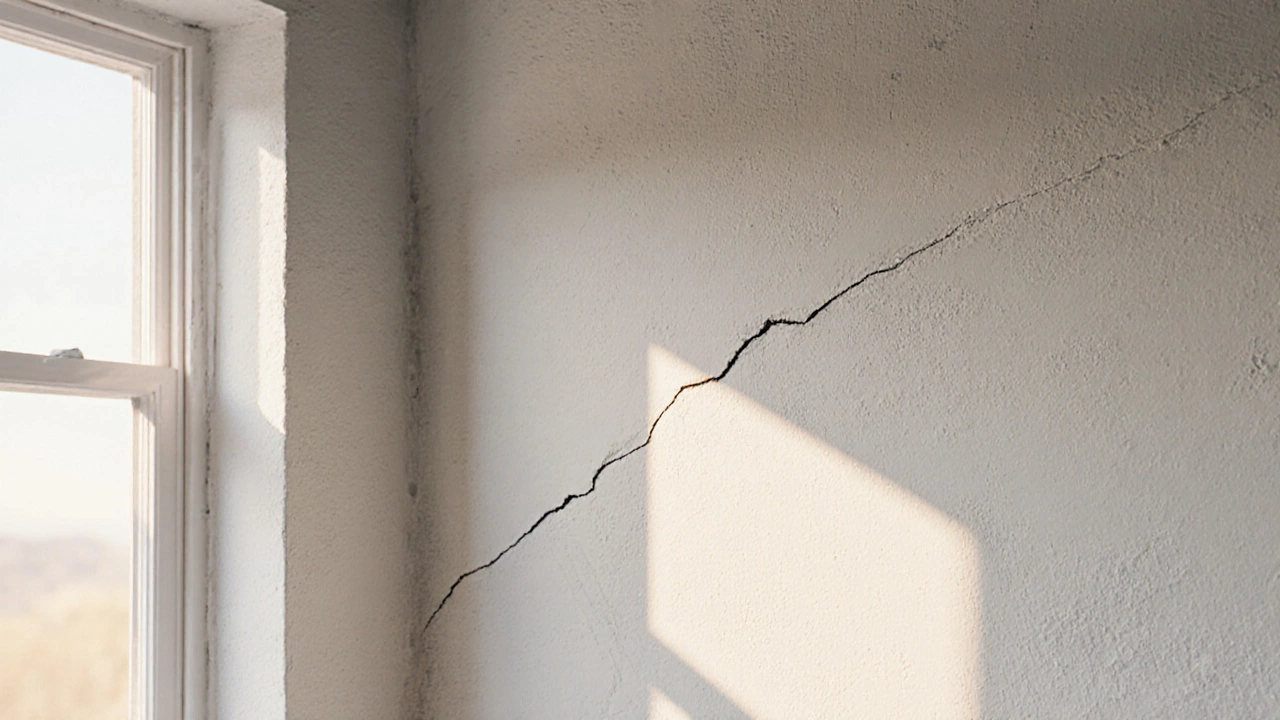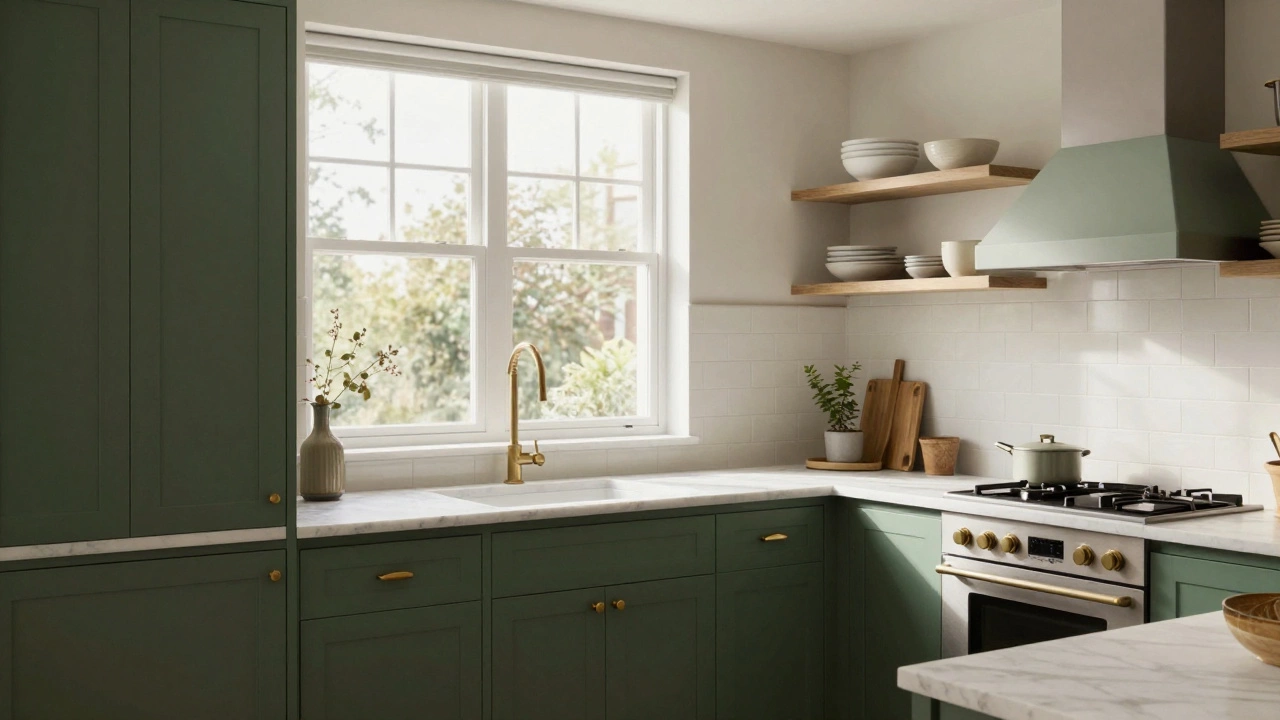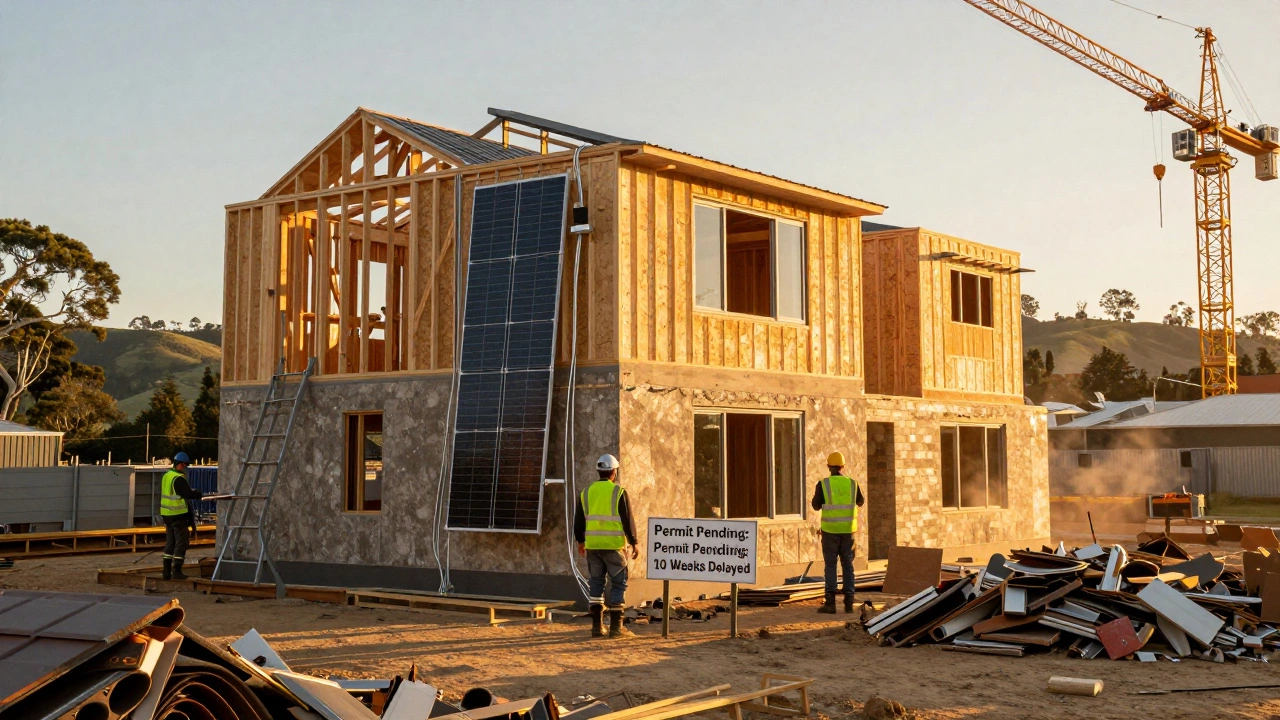Ever find a crack down in your basement and wonder if you really need to jackhammer your yard or if a quick patch inside will do the trick? If your home is showing signs of foundation cracks, figuring out where to start can feel like a headache. Some folks say just seal it from the inside and move on. Others swear you need to go outside, dig down to the roots, and fix the problem from the source. Who’s right?
Here’s the thing: both inside and outside fixes can work—but it depends on what you’re dealing with. Not every crack is a disaster, but ignoring them can turn minor leaks into one giant, expensive mess. Water in your basement, musty smells, or doors that don’t close right can all point to foundation trouble. Sometimes all you need is a smart, targeted repair—but knowing which approach to pick saves you a ton of cash and stress.
Let’s break down what really matters when choosing between inside and outside repairs. You'll get clear answers so you can actually solve the problem instead of just covering it up.
- Spotting the Problem: Signs of Foundation Cracks
- Why Foundations Crack: The Real Causes
- Inside Fixes: Pros, Cons, and When They Work
- The Outside Approach: When It Makes Sense
- Choosing the Right Approach for Your Home
- Extra Tips for Lasting Foundation Health
Spotting the Problem: Signs of Foundation Cracks
Cracks in your foundation don’t always mean your home’s about to collapse, but you shouldn’t ignore them. Catching problems early can save you thousands and a lot of headaches later on.
Here are the telltale signs of foundation cracks you should watch for:
- Cracks running up basement walls, especially if they’re wider than 1/8 inch.
- Gaps next to windows or door frames that weren’t there before.
- Uneven floors or spots where the floor dips.
- Doors or windows that suddenly start sticking or won’t close right.
- Damp spots or efflorescence—that’s the white, chalky stuff left by water—on basement walls.
- Moldy or musty smells coming from your basement or crawl space.
Not all foundation cracks are created equal. Here’s a simple way to tell which ones need more attention:
- Hairline cracks: Usually not a big deal if the walls stay dry, but keep an eye out for changes.
- Horizontal cracks: A big red flag, especially in block or poured concrete walls. This often points to pressure from outside soil—don’t wait on these.
- Stair-step cracks: Look for these in brick or block walls. They could mean your foundation is shifting.
- Wide or growing cracks: Any crack wider than a quarter inch, or one you notice getting bigger, deserves a closer look right away.
If you spot more than one of these, it’s time to act. Some people like to measure the crack with a ruler and mark the ends with a pencil to track if it gets bigger. Movement usually points to a bigger issue.
Here’s a quick rundown of what homeowners typically see and how often:
| Type of Crack | Common Cause | Percentage Seen in Homes* |
|---|---|---|
| Hairline Vertical | Shrinking concrete, settling | 60% |
| Stair-Step | Foundation shifting, soil movement | 20% |
| Horizontal | Soil pressure, water buildup | 15% |
| Wide/Growing | Ongoing movement or settling | 5% |
*Estimates from inspection reports in the U.S. for homes over 30 years old.
You can stop problems before they worsen by looking for these warning signs and dealing with them right away. Regular checks, especially after heavy rains or droughts, help you catch foundation issues early and avoid bigger repairs down the road. The main thing is to treat these foundation cracks seriously, but don’t panic until you know exactly what you’re facing.
Why Foundations Crack: The Real Causes
Foundation cracks don’t just appear out of nowhere—they’re the result of real, everyday issues that mess with your house’s structure. Most homes deal with one or more of these headaches at some point. Knowing what’s behind a crack can help you jump on repairs before things get worse.
Let’s start with water. When rainwater doesn’t drain away from your house, it soaks into the soil next to your foundation. If that dirt expands (like with clay-heavy soil), it puts a ton of pressure on your foundation walls. Over time, that stress pops up as cracks. On the flip side, if the soil dries out and shrinks, your foundation can settle and crack just as easily.
Weather in general is a big culprit. During freeze-thaw cycles, water in the soil freezes and pushes on your foundation, then shrinks when it melts. Do that enough times, and cracks show up without fail. In areas with rough winters—think places with lots of freeze-thaw swings—homes are hit the hardest.
Poor construction is another sneaky cause. If the builder skipped steps or used weak concrete, your foundation won’t stand up to pressure or age as well as it should. Sometimes, cracks start showing a few years after the home is built simply because corners were cut.
Trees are troublemakers too. Big trees close to your home suck up moisture from the ground. As roots expand, they can mess with soil stability or even push right up against the foundation cracks you’re trying to avoid.
- Plumbing leaks: A hidden water pipe leak under your house can slowly wash away soil, leading to foundation shifts and—you guessed it—cracking.
- Poor grading: If the dirt slopes toward your house and not away from it, water piles up where you least want it.
- Seismic activity: Even small earthquakes can flex your foundation and leave thin cracks behind.
For a quick look at how often these causes come up, check out the table below. It shows what U.S. homeowners reported as their primary foundation problem, according to a recent industry survey.
| Cause | % of Cases Reported |
|---|---|
| Poor drainage/Water pressure | 38% |
| Soil movement/Shrinking | 27% |
| Poor construction/materials | 17% |
| Trees/root issues | 9% |
| Plumbing leaks | 6% |
| Seismic activity | 3% |
The takeaway? If you spot a crack, don’t just fill it and hope for the best. Look at what’s going on around your house—solving the root problem is the only way to keep those cracks from coming back.
Inside Fixes: Pros, Cons, and When They Work
So, should you fix those foundation cracks from the inside? A lot of people go this route because it’s quick, clean, and way less of a hassle compared to digging up your yard. Inside repairs usually mean injecting epoxy or polyurethane foam right into the crack. These materials plug up the gap and stop leaks almost right away. It’s the go-to option for hairline cracks and situations where the outside of the house is tough to reach—maybe there's a deck or some big-time landscaping in the way.
Foundation cracks fixed from the inside can often be done in just a couple of hours. It won’t disturb your garden, and you generally save a chunk of money. Pricing usually starts around $400 to $800 per crack, depending on where you live and how tricky the job is. Compared to outside repairs, that’s almost always cheaper. Plus, cleanup is a breeze. There’s no mud, heavy machinery, or wrecked flower beds to worry about.
Still, there are limitations. Inside repairs mostly stop water from getting into your basement, but they don’t tackle the root cause. If the soil outside your home is the real problem, water may keep building pressure against your foundation. Eventually, the same crack could open up again or new ones might form nearby. For cracks that move a lot, or if you’ve got serious seepage every time it rains, an inside-only fix might not last.
- Best for: Thin cracks that don’t move, dry climates, and houses where digging outside isn’t possible.
- Think twice if: The crack is wide, keeps growing, or you’ve got persistent flooding and musty air.
- Not a preventive measure: Inside fixes seal up leaks but don’t stop new ones from starting if the real source is outside.
According to the American Society of Home Inspectors,
"Injected crack repairs from the inside are often effective for minor, non-structural cracks, especially if exterior access is limited."That’s a fancy way of saying: don’t expect miracles, but for small jobs, inside fixes can save your day (and your wallet).
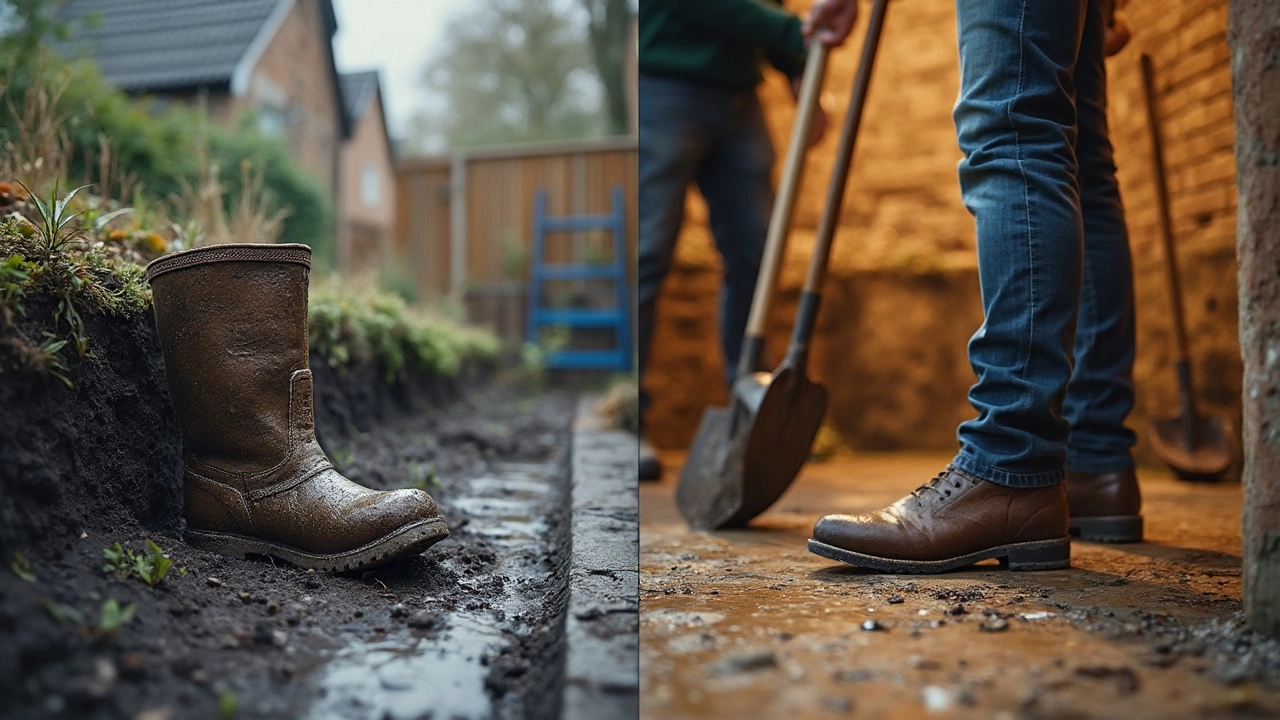
The Outside Approach: When It Makes Sense
Going at foundation cracks from the outside is a bigger job, but sometimes it’s the only thing that truly works. If water’s sneaking in through a wall, and especially if you’re dealing with bigger cracks or repeated leaks, an inside patch is like putting a bandage on a leaking pipe. Outside repairs actually stop the water at the source and keep it away from your foundation in the first place.
Outside repairs aren’t just about plugging cracks. Pros usually dig down to the footing, exposing the whole wall section with problems. Why all the digging? Because most leaks start from the outside pressure—rain, soil, and groundwater pressing right up against your house. By sealing outside, you’re controlling that problem directly.
Here’s what typically happens during an outside repair:
- They dig down to the base of your foundation wall.
- Cracks get cleaned and filled with waterproof material that can handle movement.
- A heavy-duty waterproof membrane goes on the entire exposed section for a solid seal.
- In some cases, they add a drainage board and gravel to steer water away fast.
- Soil is put back and graded so water runs away from your house instead of toward it.
This approach costs more up front—on average, outside foundation repairs in the U.S. land anywhere from $5,000 to $15,000, depending on how deep or long your wall is. But here’s the upside: A good exterior fix can last decades. No checking every rainy season. Less worry about mold or structural damage quietly building up.
| Repair Method | Average Cost (USD) | Typical Lifespan |
|---|---|---|
| Inside-only crack injection | $300 - $800 per crack | 5-10 years |
| Outside excavation + full waterproofing | $5,000 - $15,000 | 20+ years |
So when does it make sense to go through all this effort?
- You’ve got consistent leaks or standing water after rain.
- Your wall has wide or multiple cracks, not just hairline ones.
- Previous inside fixes didn’t do the trick.
- You want a permanent solution and plan to stay in the home for a long time.
- There’s sign of long-term water damage—think mold, rotting wood, or that damp, musty smell that never goes away.
Sometimes, a mix of both inside and outside work gets the job done best. But if you’re after real peace of mind, the outside fix is the “one and done” choice. Just know it’s a messier process—your yard will need some TLC after all the digging. Still, you get a solid fix that stops water and keeps your foundation rock-solid for years to come.
Choosing the Right Approach for Your Home
Picking the best fix isn’t about one-size-fits-all advice. It comes down to the exact problem you see, how bad it’s gotten, and what you actually want to achieve. First, check if your crack is leaking. If it’s dry and just a hairline crack, interior repairs can usually get the job done—especially when you just want to keep water out. But if there’s a steady leak, crumbling concrete, or shifting walls, you might need to tackle it from outside, where the problem actually starts.
Here are a few things to weigh before picking your game plan:
- If you see simple vertical cracks, especially in poured concrete, most pros say it’s often safe to use an interior epoxy or polyurethane injection. That stops leaks and seals things without any heavy digging.
- For outside fixes, you'll need excavation. This means digging down to reach the wall from outside. It works well for big horizontal cracks, bowing or bulging, or where water pushes against your wall every time it rains. This method is stronger for long-term foundation cracks issues, but it’s costlier and messier.
- Cracks wider than a quarter inch, or with signs of movement (like widening over time), should always get looked at by a pro. Sometimes these hint at deeper soil or structural issues.
- Masonry block walls (that’s the kind with concrete blocks) often need outside help, since water can travel inside the hollow spots, making inside-only repairs pretty useless in the long run.
Here’s a quick breakdown of what to expect, money-wise and time-wise:
| Repair Method | Cost Range (USD) | Avg. Time | Best For |
|---|---|---|---|
| Interior Crack Injection | $500 - $1,200 | 2-4 hours | Hairline/vertical cracks Quick leaks |
| Exterior Waterproofing | $5,000 - $15,000* | 2-5 days | Major leaks Foundation wall movement |
*Prices can spike if there are landscaping or hard-to-reach areas. Sometimes, big trees or patios mean bigger bills.
If you’re planning to finish your basement or already have water coming in, it’s smart not to cut corners. Ask about warranties—reputable companies usually back up their work for years, especially with big exterior jobs.
The bottom line? Don’t just let price steer your decision. A quick inside patch might be fine for now, but if you want lasting peace of mind (especially in an older home or one with poor drainage), talk to a foundation specialist and get their take. Sometimes, spending more to fix it right means saving yourself from repeat headaches and costs down the line.
Extra Tips for Lasting Foundation Health
Keeping your foundation in good shape goes way beyond just fixing cracks. Most foundation trouble starts with water. If you manage water the right way around your house, you can dodge a lot of repairs down the line.
- Foundation cracks often start or get worse from poor drainage. Make sure gutters and downspouts push water at least six feet away from your home. You don’t want water soaking the soil next to your foundation, because that soil expands and contracts, which messes with your foundation.
- Watch the grading of your yard. The ground should slope away from your home on all sides. Just a two-inch drop every 10 feet can help a bunch. If water puddles near your foundation after it rains, you probably need to regrade.
- Check plumbing and sump pumps often. Even small leaks can soften up the dirt under your foundation, which can lead to new cracks or make old ones worse.
- If you have big trees close to your house, keep an eye on their roots. Roots suck up water, but they can also push against your foundation or shift soil, creating gaps.
- In dry seasons, water the soil around your house lightly to keep it from shrinking. Don’t soak it, just aim for a steady level of moisture. Big swings between super wet and bone dry soil are what do the real damage.
Here’s some quick data that shows just how much water control can impact concrete foundations:
| Drainage Issue | Chance of New Cracks (within 5 yrs) |
|---|---|
| Poor Gutter/Downspout Setup | 65% |
| Proper Gutter/Downspout Setup | 12% |
| Negative Yard Slope | 56% |
| Positive Yard Slope | 10% |
Regular checks save money. Walk around your home every season, look for signs of shifting or leaks, and tackle any problems when they’re small. Don’t forget – sometimes the best repair is not needing one in the first place.

